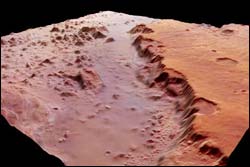This area deals with the fundamental laws and building blocks of nature and how they interact, the properties and the behavior of matter, and research into space and time and their structures.
innovations-report provides in-depth reports and articles on subjects such as astrophysics, laser technologies, nuclear, quantum, particle and solid-state physics, nanotechnologies, planetary research and findings (Mars, Venus) and developments related to the Hubble Telescope.

Self-organizing synthetic molecules originally used for gene therapy may have applications as templates and scaffolds for the production of inorganic materials. Using electrostatic interactions between oppositely charged molecules as the binding force, scientists are learning how to organize these synthetic molecules into more versatile complexes with large and controllable pore sizes.
“By investigating the fundamental design rules for the control of self-assembled supramolecular str

Sharks are, by tradition, the eternal threat facing divers. Yet, a diver is quite a lot more unlikely to meet such a creature under the water than, at some time or another, to come up against an even greater danger – hypothermia, or exposure. To enable divers to prevent this syndrome from creeping silently up on them, two researchers from the Area of Applied Physics at the University Jaume I (Spain) have formulated an equation that enables divers to calculate the time they can safely remain submerge

Development phase completion of the European-built observation module, or “cupola”, for the International Space Station will be marked by a ceremony at the Alenia Spazio facility in Turin, Italy on Monday 6 September.
The cupola, currently scheduled for launch in January 2009, is an observation and control tower for the ISS, with windows that will provide a panoramic view for observing and guiding operations on the outside of the station.
The pressurised module will accommod

These images, taken by the High Resolution Stereo Camera (HRSC) on board ESA’s Mars Express spacecraft, show the southern part of Valles Marineris, called Eos Chasma.
The images were taken during orbit 533 in June 2004, and are centred at Mars longitude 322° East and latitude 11° South. The image resolution is approximately 80 metres per pixel.
Between surrounding plains and the smooth valley floor, a height difference of about 5000 metres has been measured. The plain to the sout

Most miniature electronic, optical and micromechanical devices are made from expensive semiconductor or ceramic materials. For some applications like diagnostic lab-on-a-chip devices, thin-film polymers may provide a cheaper alternative, but the structure and properties of these materials—-often no more than a few nanometers (nm) thick—-are difficult to determine. In addition, defects in the thin polymer masking materials used to “print” integrated circuits can produce malfunctioning components.

University of Chicago scientists have solved a 20-year-old puzzle in particle physics using data from an experiment conducted for an entirely different purpose.
Physicists had long known that something was amiss regarding their understanding of how some quarks interact in the beta decay of particles, a common form of radioactivity. Either dozens of experiments conducted over a period of more than three decades were wrong, or the scientists’ theories were. Now, in a set of four